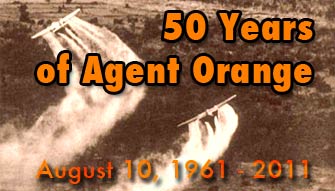 | |||||
| Vietnam Agent Orange Relief and Responsibility Campaign poster |
By Jaimie Moscarello
WHAT YOU NEED TO KNOW:
Agent Orange and Dioxin
WHAT IS IT?
Dioxin is perhaps the most toxic chemicals to man. It is the umbrella name for chemical compound containing carbon, hydrogen, oxygen and chlorine. Dioxin is formed inevitably, naturally, synthetically and is a consequence of industrial processes.
WHERE IS IT FOUND?
Dioxin is formed inevitably, naturally and synthetically. It is a consequence of industrial processes, like bleaching paper, using chlorine, and producing chemical herbicides. It is strongly connected with paper mills that use chlorine in their bleaching process.
Waste-burning incinerators and backyard burn-barrels produce the most major source of dioxin in the environment.
Dioxin is stored in the fatty tissue. Animals exposed to high levels of dioxin store the chemical compound in their fatty tissue; people who eat their meat are exposed to dioxin. Mothers who have eaten the exposed meats who are nursing their babies expose their children to dioxin.
SO WHAT?
Dioxin is a carcinogen. It causes cancer! If that isn’t scary enough, the chemical compound causes liver and kidney damage, reproductive and developmental problems. Dioxin harms your immune system and meddles with hormones.
Birth defects, miscarriages, endometriosis, decreased fertility, lower sperm counts, lower testosterone, diabetes, learning disabilities, lung problems, skin disorders like chloracne, lowered immune systems are all linked to dioxin exposure.
WHAT IS ITS HISTORY?
Dioxin was studied in 1943 by a plant biologist, Arthur Galston, who found that too much of the compound hurt plants. He was worried about what the effects of the chemicals were to people and the environment.
EXPERIMENT
70 male inmates at Holmesburg Prison in Northeast Philadelphia were part of an experiment in the 1960’s to determine the risks of dioxin. The inmates’ health became poor, as expected. The names of the inmates were not released and the public was not aware of the experiment until 1980.
USES DURING VIETNAM WAR
The use of Agent Orange in the Vietnam War took place between 1961 and 1971. In those ten years, the US military sprayed about 20,000,000 gallons of chemical herbicides. That’s 20 million gallons of dioxin-contaminated Agent Orange and other chemicals to clear rural and forestland so the enemy couldn’t have food and cover.
The mission, Operation Ranch Hand, used aircraft to spray the herbicides. The campaign destroyed 5 million acres of land and crops.
VIETNAMESE PEOPLE AND VETS
The Vietnam Red Cross estimates at least 3 million people, including 150,000 children suffer from dioxin exposure. Women in Southern Vietnam had higher rates of miscarriages and stillbirths; livestock were affected in the same way.
Children affected have health problems, like cleft palates, mental disabilities, and extra fingers and toes.
Dioxin was found in Vietnamese women and in the blood of soldiers who served in Vietnam. It’s also still contaminating soil and sediment.
Birth defects in generations of the Vietnam War or Korean War veterans are associated with dioxin.
WAY TO GO NJ!
In 1980, New Jersey created the NJ Agent Orange Commission, the first state commission to study the effects of dioxin. Gov. Christine Todd Whitman disbanded the commission in 1996.
HELPING OUT
Peace Villages exist in Vietnam, to provide victims of Agent Orange medical and psychological help. The Vietnamese government and Vietnam Red Cross give money to centers caring for dioxin victims.
There are many organizations that are doing something about dioxin.
Make Agent Orange History is a site where you can learn more about the most dangerous chemical compound known to man and volunteer your time and money.
Learn more:
makeagentorangehistory.org/
www.publichealth.va.gov/exposures/agentorange/basics.asp
www.cancer.org/cancer/cancercauses/othercarcinogens/intheworkplace/agent-orange-and-cancer
No comments:
Post a Comment